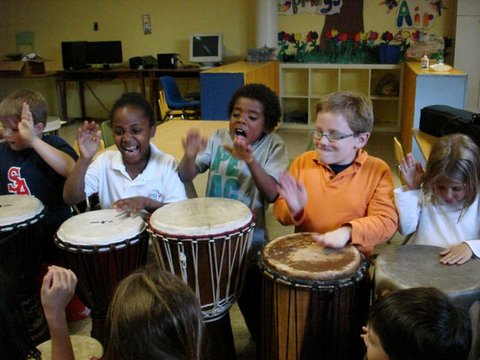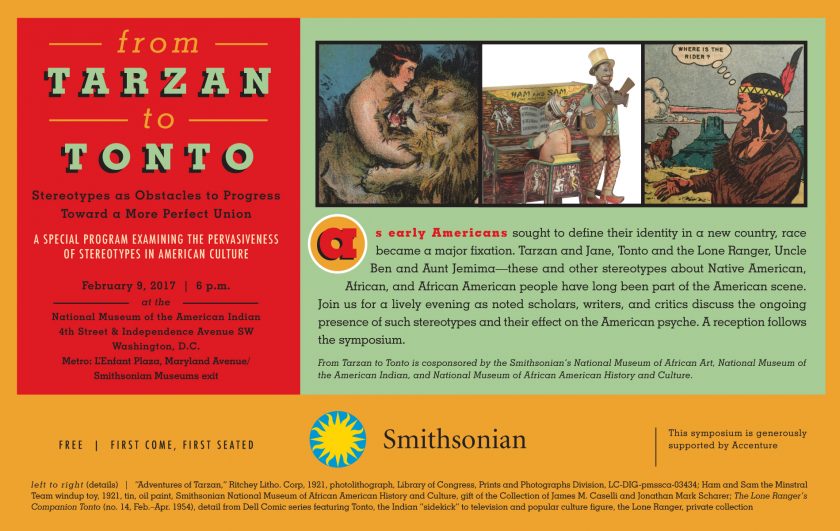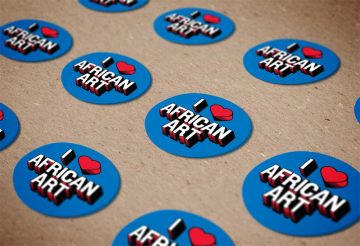The NMAFA Education Department also brings to life the art and cultures of Africa through workshops. These programs feature local and African artists, writers and educators.
Workshop Wednesdays
1:30–3:30 p.m.
 Spark your creativity and intellectual curiosity during Workshop Wednesdays at the National Museum of African Art! Workshops on the first and third Wednesdays of every month highlight a different artistic process (no workshop will be held July 4). Stay for as little or as long as you like to complete your masterpiece. All skill levels and ages welcome; participants under age 16 must be accompanied by an adult. Most of these events require no registration, and drop-ins are welcome (though please remember that all workshops are first-come, first-served events). However, due to limited space, several workshops do require prior registration. Please refer to the list above for those requiring registration.
Spark your creativity and intellectual curiosity during Workshop Wednesdays at the National Museum of African Art! Workshops on the first and third Wednesdays of every month highlight a different artistic process (no workshop will be held July 4). Stay for as little or as long as you like to complete your masterpiece. All skill levels and ages welcome; participants under age 16 must be accompanied by an adult. Most of these events require no registration, and drop-ins are welcome (though please remember that all workshops are first-come, first-served events). However, due to limited space, several workshops do require prior registration. Please refer to the list above for those requiring registration.
Throughout the year, special masterclass editions of Workshop Wednesdays will be held. These masterclasses will offer the unique chance to explore select artistic topics more deeply and learn from the same artists whose work you see on our walls and in our incredible collections. Masterclasses are intended for participants 16 and up. Registration is required, and space is limited! Check back for the release of the full calendar of masterclasses.
Looking for Contours
February 5
1:30–3:30 p.m.
Using viewfinders, participants examine and record the contour lines of artworks on exhibit to use as inspiration for a painting
It’s Just Hair
February 19
1:30–3:30 p.m.
Reflecting on image identity and beauty challenging our reality and social norms of beauty and acceptance, participants are asked to imagine hair as an accessory and not a necessity, to see hair as a material and used like an object. Participants then create an accessory of their choice using the provided material.
Pendants that Please
March 4
1:30–3:30 p.m.
Throughout Africa, pendants of varying intricacy, material, symbolism, and meaning reflect individual cultures and regions. Pendants and charms are not only a way of “dressing up” and feeling elegant, but also indicate one’s status, bring good fortune, and protect their owners. Examine the complex designs of the various jewelry and metal objects on exhibit before creating a piece of your own.
The Art of African Fabric
March 18
1:30–3:30 p.m.
Textiles—an intrinsic part of the daily life of Africa’s peoples—have been used as communication tools, celebratory adornments and gifts, political statements, and so much more. Explore textiles in Heroes: Principles of African Greatness and create an artwork adhering to the regional interpretation of the fabric.
Register through Eventbrite
The Eyes Have It
April 1
1:30–3:30 p.m.
Learn about the art of the kingdom of Benin and how its artists used a stylized African eye motif throughout their sculpture. Then, breakdown the shapes of this traditional design element to create your own contemporary abstract work of art. Emphasis will be placed on the elements of art—line, shape, color, and texture—and the principles of balance, rhythm, emphasis, and harmony.
Egyptian Culinary Arts
April 15
1:30–3:30 p.m.
Egypt is not only famous for pyramids and ancient history but also for the amazing food influenced by the convergence of several civilizations in the region. Join gourmet chef Aida Mady as she shares her love and indigenous knowledge of Egypt’s culinary arts. Learn about the use and health benefits of traditional spices before making a special dessert.
Elegant Amulets
May 6
1:30–3:30 p.m.
Throughout Africa, amulets, decorated pouches, and charms are worn to bring good fortune or protect their owners. Learn more about this ancient tradition and create your own to ensure well-being.
Card Design with Adinkra Symbols
May 20
1:30–3:30 p.m.
Adinkra symbols, visual representations of concepts and proverbs developed by the Akan peoples of Ghana, were originally used on funerary cloths by royalty and wealthy individuals to pay tribute to the legacy of the deceased. Today, they are used extensively as decorative elements in textiles and design. Join graphic artist and designer Sharmila Karamchandani to learn about adinkra symbols before incorporating them into a one-of-a-kind card.
I Am
June 3
1:30–3:30 p.m.
Just as contemporary artists create artworks that reveal not only themselves, but their thoughts about economic, political, and environmental climates, participants will explore personal thoughts about themselves to compose a poem that defines who they are.
It’s Just Hair
June 17
1:30–3:30 p.m.
Reflecting on image identity and beauty challenging our reality and social norms of beauty and acceptance, participants are asked to imagine hair as an accessory and not a necessity, to see hair as a material and used like an object. Participants then create an accessory of their choice using the provided material.
Abstract Script Compositions with Uli Designs
July 1
1:30–3:30 p.m.
Uli patterns are used by Igbo women to decorate their bodies and the exterior of their houses. Mimicking the fabric paintings of the Nsukka artists who often explored uli’s fluid lines and symbols for inspiration, participants incorporate uli patterns into their fabric creations.
Reverse Glass Painting Senegalese style
July 15
1:30–3:30 p.m.
The term fixe painting (suwer or sous-verre, “under the glass”) describes the reverse glass painting that flourished in Senegal. Create your own unique art using this technique.
Coil Baskets and Containers
August 5
1:30–3:30 p.m.
Learn the basics of coiling—a method widely used throughout Africa to make incredible pottery and basket vessels. Stop by the museum to discover this essential technique and craft a basket from paper coils. Shape, color, texture, and decoration are limited only by your imagination.
Heroes and Sheroes Design with African Fabric
August 19
1:30–3:30 p.m.
Create a red-carpet masterpiece on painters canvas with fashion designer Almira Leónché. Discover your creative side as you design, choose fabric, and embellish an evening gown or cocktail dress to make a 3-D wall art piece to remember.
I Am
September 2
1:30–3:30 p.m.
Just as contemporary artists create artworks that reveal not only themselves, but their thoughts about economic, political, and environmental climates, participants will explore personal thoughts about themselves to compose a poem that defines who they are.
Card Design with Adinkra Symbols
September 16
1:30–3:30 p.m.
Adinkra symbols, visual representations of concepts and proverbs developed by the Akan peoples of Ghana, were originally used on funerary cloths by royalty and wealthy individuals to pay tribute to the legacy of the deceased. Today, they are used extensively as decorative elements in textiles and design. Join graphic artist and designer Sharmila Karamchandani to learn about adinkra symbols before incorporating them into a one-of-a-kind card.
Free and open to the public
A Special Program Examining the Pervasiveness of Stereotypes in American Culture
As early Americans sought to define their identity in a new country, race became a major fixation. Tarzan and Jane, Tonto and the Lone Ranger, Uncle Ben and Aunt Jemima—these and other stereotypes about Native American, African, and African American people have long been part of the American scene. Watch as noted scholars, writers, and critics discuss the ongoing presence of such stereotypes and the barriers these stereotypes pose to the advancement of American culture.
Gaurav Desai, professor of English Language and Literature, University of Michigan; Adrienne Keene (Cherokee Nation), assistant professor, American Studies and Ethnic Studies, Brown University; Imani Perry, Hughes-Rogers Professor of African American Studies, Princeton University; and Jesse Wente (Ojibwe), leading film critic and programmer for indigenous cinema, presented various perspectives on the topic. Tiya Miles, Mary Henrietta Graham Distinguished University Professor of African American Women’s History, professor of Afroamerican and African Studies, professor of American Culture, professor of History, and professor of Women’s Studies, University of Michigan, served as the evening’s moderator.
A reception in the museum’s Potomac Atrium followed the symposium.
Webcast
The symposium was webcast live and can be enjoyed here. Webcast viewers are encouraged to participate via Facebook and Twitter by using the hashtag #Stereotypes.
From Tarzan to Tonto, cosponsored by the Smithsonian National Museum of African Art, National Museum of the American Indian, and National Museum of African American History and Culture, was generously supported by Accenture.
Highlights From Years Past
Anna Mwalahgo and Afro-FloetryThe National Museum of African Art has incorporated visual arts programming into its museum education to create an invigorating and stimulating learning environment in which children, adults and families can discover and appreciate the profound cultural traditions of Africa.
Friday, April 18, 2008 was a night of art and fashion coming together through the designs created by students from St. Timothy’s School. Using their own unique styles, students used inexpensive and recyclable materials to fabricate an innovative line of wearable art.
Presented by the Art Club of St. Timothy’s School in conjunction with El Anatsui’s GAWU exhibit.
The National Museum of African Art has incorporated visual arts programming into its museum education to create an invigorating and stimulating learning environment in which children, adults and families can discover and appreciate the profound cultural traditions of Africa.
On July 11, 2007, in front of a lively audience, Kankouran West African Dance Company delivered an exciting and engaging performance. Despite the day being one of the hottest of the summer, the performers had more than enough energy for high-powered kicks, stomping, shimmies and drumming. Between dances, Artistic Director Assane Konte spoke proudly of the 34 members in his troupe. He explained how the drum-based music and the dances tell the history of Africa. He also spoke of the importance of children and community, and he even invited young audience members to come up front and join in the dances. This local dance company, based in Washington, D.C., has been an integral part of the dance community for over 20 years.
The National Museum of African Art has incorporated visual arts programming into its museum education to create an invigorating and stimulating learning environment in which children, adults and families can discover and appreciate the profound cultural traditions of Africa.
This video is from a multimedia performance by Ayo Ngozi at National Museum of African Art, Smithsonian Institution, on May 31, 2008. The performance was in conjunction with El Anatsui’s “Gawu” exhibition, featuring Ashley Brockington, Tosha Grantham, Takeyah Young (live human sculpture); Yoko K. (original music and sound design); Basel Action Network (video).
The National Museum of African Art has incorporated visual arts programming into its museum education to create an invigorating and stimulating learning environment in which children, adults and families can discover and appreciate the profound cultural traditions of Africa.
This video is called 70 and is from a multimedia performance by Ayo Ngozi at National Museum of African Art, Smithsonian Institution, on November 8, 2008. The performance is a celebration of the life of Fela Anikulapo Kuti, featuring Ayodamola Okunseinde, Hesihima James, Hambone Swamp Guinee, Torkwase Dyson, Ernesto Mercer, Tazima Davis, Holly Bass, Tierra Buggs, Samaa Claiborne, Melani N Douglass, Candace Mickens, Nakima Smith. This video is courtesy of Juju Films Productions.
Part 1:
Part 2:
Backstage:
The National Museum of African Art has incorporated visual arts programming into its museum education to create an invigorating and stimulating learning environment in which children, adults and families can discover and appreciate the profound cultural traditions of Africa.
This video is from Award winning composer, playwright and pianist Tony M. Small. He performed original works from his Tales and Traditions series including It Takes a Village, and other original music that shows the rich connection and influence of African culture on America’s indigenous Tales and Traditions.
Part 1:
Part 2:
For Black Music Month Howard University Dance Ensemble performed traditional and contemporary dance with a versatile exploration through the dance forms of African, modern contemporary and ballet.
As part of Women’s History Month and programming related to the Earth Matters exhibit Holly Bass presented Monument, a celebration honoring the strength and diversity of women in African and diaspora.
NMAFA’s dynamic international programming presented Ethiopian Music and Dance Group Fendika as part of its summer line up.
On August 8, 2013 NMAFA held its annual Community Day in conjunction with the Earth Matters exhibit, featuring a day filled with dance, music, art, film and food. Artists included Rennie Harris RHAW, The Chelsey Green Project and Cirquetacular.
On February 16, 2013 NMAFA presented in conjunction with Black History Month African Roots Global Reach: In Living Color. Featured performers included Maimouna Youssef, Farafina Kan, and Sound of the City.
NMAfA’s continued endeavor to explore and present dynamic works from African and its disapora is pleased to host Haitian-American violinist and composer Daniel Bernard Roumain (DBR) and the world premiere of a new solo violin & electronics work inspired by Nigerian artist Ousmane Sow’s powerful sculpture “Toussaint Louverture and the old slave.” Proving that he’s “about as omnivorous as a contemporary artist gets” (New York Times), DBR is perhaps the only composer who has collaborated and performed with Philip Glass, Cassandra Wilson, Bill T. Jones, and Lady Gaga. DBR will be joined by legendary emcee, producer, actor and director and member of the hip-hop group Brand Nubian Lord Jamar in creating a powerful, genre-bending, contemporary performance. In conjunction with Black History Month.
http://vimeo.com/37880179
The National Museum of African Art presented musician and visual Artist Vernon Reid (of Living Colour and Black Rock Coalition) performing Artificial Afrika in celebration of Black Music Month on Saturday, June 25. A Q&A session led by DJ Adrian Loving took place afterward. Please enjoy the entire show.
Holly Bass Performance Projects interprets Yinka Shonibare’s work through their new performance piece African Futures: DC. Dancers Andile Ndlovu from South Africa and Ayano Kimura from Japan, under the artistic guidance of Septime Weber of the Washington Ballet. Also perfrom a short interprestive piece in response to Shonibare’s Odile and Odette.
A collaboration with the Sultanate of Oman and the Sultan Qaboos Cultural Center. The troupe hails from Ja’alan Bani Bu Ali an oasis market town in Oman. Traditional Omani music has a long legacy, where the indigenous Arab Islamic culture has combined with external influences from Oman’s trading partners in East Africa and Asia. They are recognized not only for the skill of their musicians and the quality of their singing, but also for the energy and exuberance that they bring to each performance.

